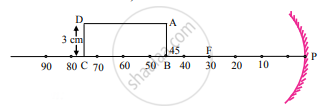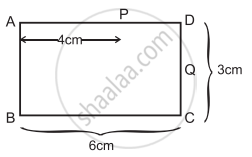Advertisements
Advertisements
Question
Answer the following question.
What is focal power of a spherical mirror or a lens? What may be the reason for using P = `1/"f"` as its expression?
Solution
- Converging or diverging the ability of a lens or of a mirror is defined as its focal power.
- This implies, the more the power of any spherical mirror or a lens, the more is its ability to converge or diverge the light that passes through it.
- In the case of a convex lens or concave mirror, the more the convergence, the shorter is the focal length as shown in the figure.

- Similarly, in the case of a concave lens or convex mirror, the more the divergence, the shorter is the focal length.
- This explains that the focal power of any spherical lens or mirror is inversely proportional to the focal length.
- Hence, the expression of focal power is given by the formula, P = `1/"f"`.
APPEARS IN
RELATED QUESTIONS
Two plane mirrors are inclined at angle of 40° between them. Number of images seen of a tiny object kept between them is ______.
Choose the correct option.
Which of the following aberrations will NOT occur for spherical mirrors?
At which positions of the objects do spherical mirrors produce a magnified image?
State the restrictions for having images produced by spherical mirrors to be appreciably clear.
Solve Numerical example.
Estimate the number of images produced if a tiny object is kept in between two plane mirrors inclined at 35°, 36°, 40° and 45°.
Solve Numerical example.
A rectangular sheet of length 30 cm and breadth 3 cm is kept on the principal axis of a concave mirror of focal length 30 cm. Draw the image formed by the mirror on the same diagram, as far as possible on scale.

A car uses a convex mirror of curvature 1.2 m as its rear-view mirror. A minibus of cross-section 2.2 m × 2.2 m is 6.6 m away from the mirror. Estimate the image size.
Solve Numerical example.
Figure below shows the section ABCD of a transparent slab. There is a tiny green LED light source at the bottom left corner B. A certain ray of light from B suffers total internal reflection at nearest point P on the surface AD and strikes the surface CD at point Q. Determine refractive index of the material of the slab and distance DQ. At Q, the ray PQ will suffer partial or total internal reflection? [Angles of the most popular Pythagorean triangle of sides in the ratio 3:4:5 are nearly 37°, 53°, and 90°]

A 4.5 cm long needle is placed 10 cm away from a convex mirror of focal length 16 cm. Locate the image of the needle from the mirror.
Where should a person stand in front of a concave mirror of radius of curvature 20 cm to get a real image of his own, 2 times larger?
Which of the following statements is incorrect?
An object is placed at a distance u from a concave mirror and its real image is formed on the screen placed at distance v from the mirror. If f is the focal length of the mirror, then the graph between `1/"v"` versus `1/"u"` is (magnitude only).
An object is placed at a distance u from a concave mirror and its real image is formed on the screen placed at distance v from the mirror. If f is the focal length of the mirror, then the graph between `1/"v"` versus `1/"u"` is (magnitude only).
For convex mirrors, whatever may be the position of the object, the image formed is always on the ______.
A large glass slab `(µ = 5/3)` of thickness 8 cm is placed over a point source of light on a plane surface. It is seen that light emerges out of the top surface of the slab from a circular area of radius R cm. What is the value of R?
The lower half of a concave mirror is covered with Opaque material. Then ______.
